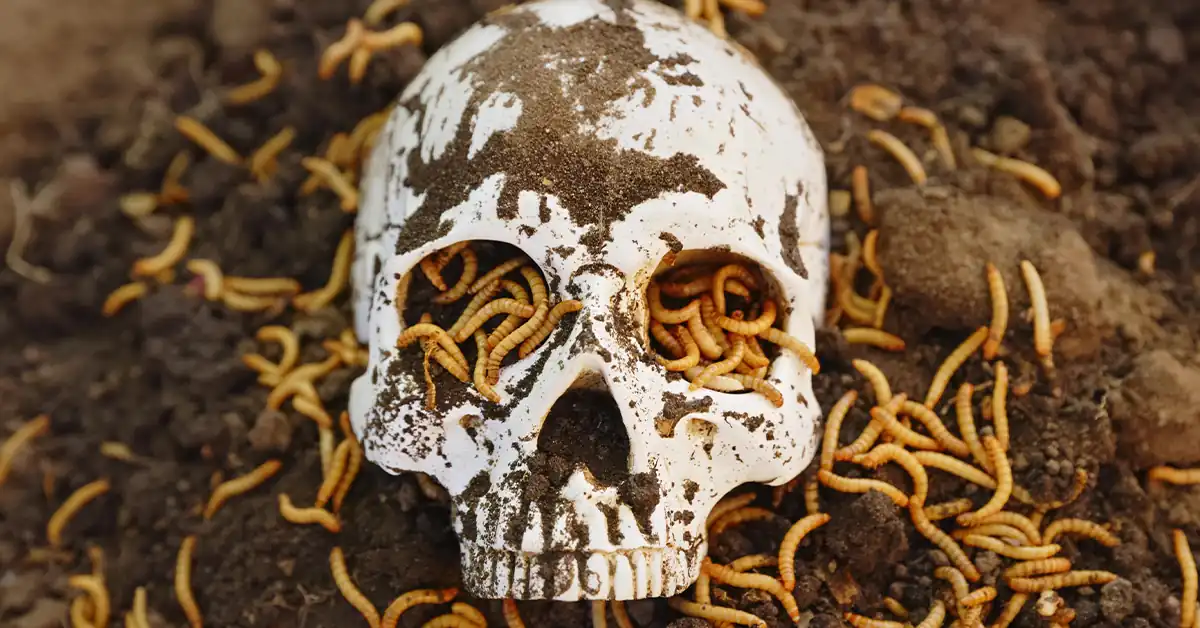“Their Worm Shall Not Die” Explained

Does “Their Worm Shall Not Die” Teach Eternal Torment?
The phrase “their worm shall not die” is often cited as a proof-text for Eternal Conscious Torment (ECT). But when read in its own literary and biblical context, it is apocalyptic, symbolic language describing the certainty and completeness of divine judgment, not an ontological statement that punishment is endless. This article explains why the text does not establish eternality in punishment, shows how ECT and annihilationism both misread the imagery, and offers a restoration-centered reading that honors the prophetic idiom and the wider witness of Scripture.
The Key Texts In View
Isaiah 66:24
“They shall go out and look on the dead bodies of the men who have rebelled against me; for ‘their worm shall not die, their fire shall not be quenched,’ and they shall be an abhorrence to all flesh.”
Mark 9:48
“Where ‘their worm does not die and the fire is not quenched.’”
These are the locus classicus for the claim that hell is never-ending torment. But notice at the outset what Isaiah actually describes: dead bodies in the aftermath of judgment.
What The Language Is (And Isn’t) Doing
- Corpses, not conscious souls
Isaiah is explicit: onlookers behold “dead bodies.” Worms consume corpses; they are not torturing living, immortalized beings. The scene depicts the disgrace and finality of overthrow, not the perpetuation of life in agony. Turning maggots into everlasting tormentors requires importing ideas foreign to the passage. - “Not quenched” means unstoppable, not unending
Biblically, “unquenchable fire” is idiom for a judgment that cannot be resisted until it has fully accomplished its purpose. Jeremiah 17:27: “I will kindle a fire in its gates, and it shall devour the palaces of Jerusalem and shall not be quenched.” Jerusalem is not still burning today, yet that fire was “unquenchable” in the prophetic sense: no human could put it out prematurely. The idiom signals inevitability and completeness, not everlasting duration. See also Ezekiel 20:47; Amos 5:6; Matthew 3:12. - “Worm shall not die” is a stock image of total consumption and disgrace
In the ancient world, the dishonor of an unburied body left to decay was a known symbol of defeat. Saying the worm “shall not die” heightens the picture: the consuming agents of decay will not be interrupted before their work is done. The focus is certainty, not perpetuity. - Apocalyptic rhetoric shocks to awaken, not to define metaphysics
Prophetic and apocalyptic texts use vivid, exaggerated images to portray the terror and inevitability of divine judgment. Isaiah 34:10 speaks of Edom’s smoke going up “forever”; it is not a claim that smoke particles will literally billow without end, but a way of saying its downfall is total and its memory infamous. Reading “worm” and “fire” woodenly creates absurdities (immortal maggots, endlessly burning yet never-consuming flames). - Jesus invokes Isaiah as a moral warning, not as a metaphysical map
In Mark 9, the Isaiah citation drives home the seriousness of stumbling and the urgency of radical self-amputation from sin. The function is exhortational: do whatever it takes to avoid judgment. It is not a technical manual on the mechanics or duration of post-mortem punishment.
Why ECT Fails Here
ECT treats idioms of certainty as statements of endless duration and transforms images attached to corpses into a doctrine of living souls tormented without end. It collapses prophetic picture-language into literal, eternal mechanics. That move ignores the Old Testament’s consistent usage of “unquenchable fire” and “everlasting smoke” as markers of unstoppable, memorable judgment, not as timers set to infinity.
Why Strict Annihilationism Also Falls Short
Annihilation rightly recognizes that the scene in Isaiah is death, not life in agony. Yet, when annihilationism treats the imagery as proof of an irredeemable, final extinguishing of persons, it can flatten the prophetic purpose of judgment. Scripture often portrays God’s judgments as severe, decisive, and purifying, aimed at ending rebellion and restoring order under God’s reign. The imagery points to the completeness of overthrow; it does not foreclose God’s larger purpose to reconcile all things.
A Restoration-Centered Reading
- The subject is the certainty and completeness of judgment
“Worm” and “unquenchable fire” announce that no one will halt God’s verdict. The disgrace is real; the overthrow is total. - The scope of apocalyptic images is moral memory, not eternal mechanics
The scene functions as a cautionary memorial of rebellion’s end. It declares that human pride ends in shame, not that God delights in eternal cruelty. - Judgment serves God’s saving rule
Throughout Scripture, judgment clears the field for new creation. Even after cataclysmic oracles, the prophetic arc bends toward renewal, comfort, and nations streaming to Zion. Isaiah’s book itself moves from woe to consolation and worldwide worship. The final word is God’s victory and the healing of the nations, not an everlasting torture chamber.
Handling “Unquenchable Fire” In Scripture
The phrase marks a fire no one can put out, not one that never completes its work. The same idiom describes temporal judgments that came and went, but could not be averted once decreed. When applied to divine judgment, it underscores God’s sovereignty: His verdict cannot be doused by human power or policy.
References for study: Jeremiah 17:27; Ezekiel 20:47; Amos 1–2; Matthew 3:12.
Handling “Their Worm Shall Not Die”
The possessive “their” ties the disgrace to the rebels; the worm “shall not die” until the consuming is finished. The image does not make maggots immortal; it makes the shame inescapable. In biblical lament and prophecy, “worm” language is stock vocabulary for corruption and humiliation (see Job and Psalms). Isaiah intensifies that vocabulary to paint the horror of rebellion’s end.
What About Gehenna?
When Jesus warns about Gehenna, He taps a well-known symbol of defilement and divine judgment connected with the Valley of Hinnom in Jeremiah (child sacrifice, desecration, and forecast desolation). Whether or not one insists on later garbage-dump details, the force of the image is the same: a place associated with shame, ruin, and the erasure of pride before God. It signals the outcome of covenantal infidelity, not a metaphysical geography for everlasting torment.
References for study: Jeremiah 7:31–33; 19:6–13; 32:35.
A Side-By-Side Summary
ECT
Reads “unquenchable” and “shall not die” as duration to infinity, converts corpse-imagery into conscious souls, and turns warning rhetoric into metaphysical blueprint.
Annihilation
Sees death, not torment, but can treat the imagery as final extinction that leaves no horizon for God’s universal victory.
Restoration-Centered
Sees apocalyptic idioms stressing certainty and completeness of judgment, honors the textual focus on corpses and disgrace, and situates judgment within God’s larger purpose to end evil and make all things new.
Pastoral Takeaways
- The warning is real. God’s judgment is inescapable and total; pride ends in shame.
- The imagery is rhetorical, not mechanical. Do not build eternal metaphysics from prophetic hyperbole.
- God’s purpose is victorious. Judgment clears the ground for reconciliation under the Lord’s peaceful reign.
Frequently Asked Questions
Does “not quenched” mean forever?
No. It means no one can put the fire out before it has consumed what God appoints.
Does “worm shall not die” mean maggots live endlessly?
No. It intensifies the image of certain, unimpeded decay of corpses, signaling disgrace and the completeness of overthrow.
If the scene is about corpses, why does Jesus quote it to disciples?
To warn that sin’s path ends in ruin and shame. The function is ethical and urgent, not a primer on the metaphysics of hell.
Conclusion
“Worm shall not die” and “fire not quenched” are prophetic idioms that communicate the inevitability and completeness of divine judgment. They do not teach that punishment is endless, conscious torment. Nor do they constrain God to a future with no remedy. Read in context, they humble human pride, vindicate God’s justice, and leave room for His final victory.
- 08/27/2025
- WRITE A COMMENT
Recent Posts
- The Eternal False Translation: How Aionios Was Corrupted Into Eternal
- The Rich Man and Lazarus
- Does Grace Last Forever?
- His Love Never Fails
- Love and Forgive Your Enemies
- His Mercy Endures Forever
- Scriptures That Teach Universal Reconciliation
- The Lesson of James, Peter and John
- Progressive Salvation is Biblical!
- The Gates Never Shut!


